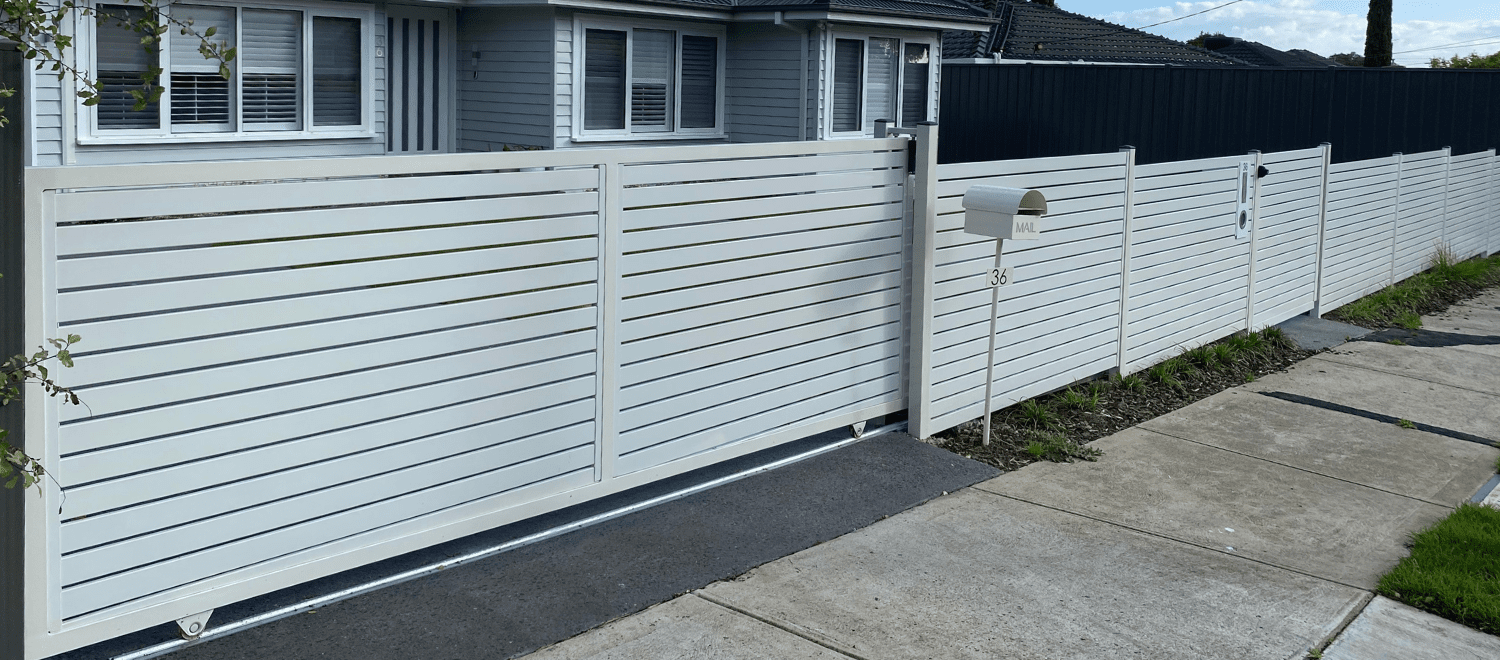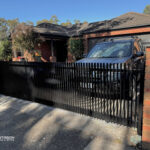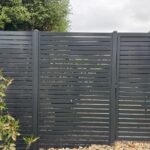In Melbourne, the cost of fencing per metre in 2025 varies widely depending on the material, style, and complexity of installation. On average, homeowners can expect prices to start from around $40 per metre for basic vinyl options and rise to over $1,000 per metre for premium brick or rendered walls. Labor, site conditions, and council regulations can also influence the final figure, making it important to plan with both material and installation costs in mind.
Below is a clear breakdown of fencing costs per metre to help you choose the best option for your home.
What Influences Fence Installation Costs in Melbourne?

In Australia, fencing costs are generally determined on a per metre basis, considering both the expense of installation labor and the necessary materials. The total cost per metre can vary significantly, ranging from $40 to $1200 per metre. Depending on the chosen material and complexity of the installation.
Fencing prices in Melbourne are influenced by more than just the material. Local factors play a major role in determining the final cost of your project:
-
Labour Costs: Fencing contractors in Melbourne generally charge between $60 and $90 per hour, depending on experience and project complexity. Installation on flat, clear land is faster and cheaper, while sloped blocks, rocky soil, or difficult access can raise costs.
-
Climate Conditions: Melbourne’s unpredictable weather, with heavy rain, strong winds, and high UV exposure, can shorten the lifespan of untreated materials. Colorbond steel and aluminium are preferred for their durability, while timber requires ongoing maintenance and sealing to withstand the climate.
-
Coastal Influence: If your property is in bayside or coastal areas, salt air can accelerate corrosion in cheaper metals. Choosing powder-coated aluminium or Colorbond is a smarter long-term investment.
-
Council Regulations: Most Melbourne councils allow boundary fences up to 2.0 metres without a permit, but front fences often have stricter limits. Applying for permits or adjusting designs to meet council rules can add time and cost.
-
Material Availability: Fluctuations in timber and steel prices affect Melbourne fencing costs. In 2025, timber prices remain high compared to pre-pandemic levels, while Colorbond has become a more stable option.
Key takeaway: Melbourne homeowners should factor in both upfront installation costs and long-term maintenance when comparing fencing materials. While timber may appear cheaper initially, ongoing upkeep often makes Colorbond or aluminium more cost-effective over time.
Read more: The Cost of Installing a Front Fence with an Automatic Gate
Pro Tips: Saving on Fencing Costs in Melbourne
-
Compare Multiple Quotes
Always request at least 2–3 quotes from local fencing contractors. Prices can vary significantly depending on availability, workload, and material suppliers.
-
Choose Materials Wisely
Treated pine paling or Colorbond panels often provide the best balance of cost, privacy, and durability. Premium options like brick or glass look great but can quickly exceed your budget. -
Plan Ahead for Site Prep
Clearing old fences or vegetation before your installer arrives can cut down on labour charges. If your property is sloped, discuss retaining wall needs early to avoid surprise costs. -
Check Council Rules First
Melbourne councils have specific height and style limits for boundary and front fences. Knowing these before you start will save money on redesigns or permit issues.
See our guide to affordable fencing options in Melbourne for more cost-saving ideas
Updated Fencing Cost Table (AUD per metre, including materials + installation)
When choosing a new fence, cost is one of the biggest considerations for Melbourne homeowners. The table below provides an updated 2025 comparison of fencing costs per metre across popular materials, with prices including both materials and installation. This makes it easy to see which option best suits your budget and lifestyle.
| Fence Material | Average Cost (AUD per metre) | Key Benefits | Best For |
|---|---|---|---|
| Vinyl / PVC | $40 – $90 | Low maintenance, affordable | Quick installs, rental properties |
| Timber Paling | $75 – $120 | Natural look, budget-friendly privacy | Backyards, family homes |
| Hardwood Timber | $80 – $150 | Strong, long-lasting, premium look | Homes needing extra durability |
| Colorbond Steel | $85 – $140 | Weather-resistant, modern style | Boundary fences, coastal homes |
| Aluminium Slat | $120 – $180 | Stylish, customisable, rust-resistant | Modern residential projects |
| Tubular Steel | $180 – $350 | Security-focused, strong lines | Front fences, high-security needs |
| Glass (semi/full) | $200 – $600 | Premium aesthetic, pool-safe | Luxury homes, pool areas |
| Brick / Rendered | $550 – $1000+ | Maximum durability & privacy | High-end properties |
Pro insight: While timber paling remains one of the cheapest and most common fencing choices in Melbourne, many homeowners are moving toward Colorbond and aluminium slats for their balance of low maintenance, weather resistance, and modern aesthetics.
Read more: The Cost of Boundary Fences in Melbourne in 2025: A Comprehensive Guide
Estimate Fence Costs by Each Type of Fence
1. Timber Fencing Cost per Metre

Timber fencing cost per metre can vary based on the type of timber and the specific requirements of the project. Here’s a breakdown of the expected costs:
- Timber Paling (treated pine): $150–$180/m at ~1.8 m height (Melbourne jobs).
- Hardwood Timber: $80–$150/m (national guidance; Melbourne often skews higher with labour/height).
Treated softwoods like pine are generally more affordable than hardwoods but require proper treatment and maintenance to prevent rotting. It’s essential to ensure that treated timber complies with Australian Standard AS1604 to meet durability and safety standards.
Hardwoods are classified based on their durability, with Class 1 woods being the most resilient and Class IV woods being less durable. Class 1 timbers, such as ironbark and grey gum, typically command higher prices due to their longevity and strength.
When planning a timber fencing project, it’s crucial to consider factors such as the type of timber, treatment requirements, and durability classifications to make an informed decision based on your budget and preferences.
To see typical timber fencing rates in Melbourne and what drives the price, check our full guide: How Much Does Timber Fencing Cost
2. Colorbond Fencing Cost per Metre

The cost of Colorbond fencing per metre can vary depending on factors such as location, design specifications, and additional features. Here’s an overview of the typical cost range:
Typical installed range: $90–$150/m nationally; $170–$200+/m is common on Melbourne quotes once height, sleepers and extras are added.
Notes: Lattice tops, plinth/sleeper bases, and taller panels push costs up.
Colorbond fencing is a popular choice due to its lightweight, durability, and versatility. With a wide range of contemporary colors available, including standard and newer options, Colorbond fencing offers flexibility to match any home style or color scheme. Additionally, Colorbond fencing can be painted to achieve custom color preferences, further enhancing its adaptability.
When budgeting for Colorbond fencing, it’s important to consider the specific requirements of your project, such as the height, length, and any additional features or accessories. Additionally, regional pricing variations may impact the overall cost, so it’s advisable to obtain quotes from local suppliers or contractors to ensure an accurate estimate for your fencing needs.
3. Aluminium Slat Fencing Cost per Metre

Aluminium slat fencing sits in the mid–premium price band because you’re paying for powder-coated aluminium, clean modern lines, and customisable privacy gaps. For Melbourne supply + install, most projects land around $280–$450 per metre, with finish, height, and site complexity pushing you toward the top end.
Typical price bands by height (Melbourne)
-
1.2 m high: ~$280–$350/m
-
1.5 m high: ~$300–$380/m
-
1.8 m high: ~$320–$420/m
-
2.0 m high: ~$350–$480/m
(Indicative installed ranges for standard powder-coat.)
Finish & style add-ons (installed)
-
Standard powder-coat (black/grey): ~$280–$380/m
-
Timber-look (e.g., Merbau, Blackbutt): ~$320–$450/m
-
Custom Dulux colour match: ~$350–$480/m
Upgrades increase coating steps and material handling, hence the lift.
What moves the price up or down
-
Slat width & gap size: Tighter gaps = more slats per metre → more material & labour. (Reason many “privacy” specs price higher.)
-
Finish: Timber-look wraps and custom colours add coatings/cure cycles.
-
Posts, frames & footings: Corner/end posts, deeper footings, or wind-rated specs add steel and labour time.
-
Gates: Pedestrian or driveway gates are quoted as separate units (hinges, frames, locks, automation).
-
Site factors: Slopes, tight access, old-fence demolition, sleepers/plinths for level changes.
-
Combinations with masonry: Brick/rendered piers with slat infills can jump to $700–$1,200+ per metre.
Looking for a complete overview of aluminium fencing options and prices? Visit our Aluminium Fencing Cost Guide
4. Tubular/Pressed Steel Fencing Cost per Metre

Tubular (sometimes called pressed or wrought-look) steel fencing is a popular choice in Melbourne for front yards, pool enclosures, and properties where visibility and security are equally important. It offers strength and durability while maintaining an open, decorative look.
For most residential projects in Melbourne, tubular steel fencing costs:
-
Basic tubular styles: $100 – $160 per metre
-
Mid-range with powder coating & decorative tops: $160 – $250 per metre
-
Premium or custom profiles (with brick piers, scrollwork, or heritage detail): $250 – $400+ per metre
These prices generally include supply and installation, but can shift upward if your site requires extra preparation, or if you add gates and automated systems.
Tip for Melbourne homeowners: Tubular steel fences are excellent for front-of-house appeal and security without blocking street views. If privacy is more important, consider pairing tubular fencing with hedges, climbing plants, or mixing sections with masonry or slat inserts for a stylish hybrid design.
5. Wrought Iron Fencing Cost per Metre

The wrought iron fencing cost per metre typically falls within the range of $450 to $600. Wrought iron fencing is renowned for its elegant and decorative appearance, adding a timeless charm to any property. With a wide array of designs available, ranging from simple and understated to elaborate and custom styles, wrought iron fencing offers versatility to complement various architectural aesthetics.
While authentic wrought iron fencing tends to be more expensive due to its durability and craftsmanship, imitation versions may offer a more budget-friendly option. However, it’s essential to consider the quality and longevity of imitation materials when making a decision.
6. Vinyl or PVC Fencing per Metre

Typical installed range: $40–$90/m (materials can be cheap; installed totals vary by framing/posts). Here’s an overview of typical prices for different types of PVC fencing:
- Two rail fence: $40 per metre
- Picket fencing: $50 to $65 per metre
- Privacy fencing: $80 to $90 per metre
PVC or vinyl fencing is known for its low maintenance characteristics, as it does not require painting, staining, or sealing, and is resistant to splintering. While PVC fencing may initially cost more or less than timber fencing depending on the specific options chosen, it often provides long-term cost savings due to its durability and minimal upkeep requirements.
If you’re considering picket fencing, our full guide on picket fence installation costs in Melbourne breaks down all the key factors.
7. Glass Pool Fencing Cost per Metre

The cost of glass fencing per metre can vary depending on factors such as thickness, style, and installation requirements. Here’s an overview of the typical prices for frameless and semi-frameless glass fencing:
- Frameless glass fencing: $275 to $600 per linear metre
- Semi-frameless glass fencing: $200 to $275 per linear metre
Glass fencing is commonly used for pool fencing or balcony balustrades, serving as both essential safety features and integral elements of landscaping. Made from tempered glass, it is highly durable and resistant to breakage, with 12mm thickness being recommended for pool fencing to minimize the risk of breakage.
Frameless glass fencing consists of glass panels secured by ground-mounted brackets, creating a sleek and seamless look. This option tends to be more expensive due to its minimalist design and specialized installation requirements.
Semi-frameless glass fencing features glass panels attached to posts, offering a combination of durability and affordability. While it is less expensive than frameless glass fencing, it still provides a stylish and modern aesthetic for pool areas and outdoor spaces.
When budgeting for glass fencing, homeowners should consider factors such as the desired style, thickness of the glass, and any additional features or customization. Obtaining quotes from reputable suppliers or contractors can help ensure an accurate estimate and satisfactory outcome for your glass fencing project.
Cost of Adding an Automatic Gate System to Your Fence (Melbourne 2025)
Adding an automatic gate system to your existing fence in Melbourne can greatly improve convenience, security, and property value — but the total cost depends on several key factors.
1. Average Cost Range for Installing an Automatic Gate (2025)
In Melbourne, homeowners can expect to pay:
-
From $2,000 – $4,500 for single swing gates (automation + motor + installation)
-
From $3,500 – $7,000+ for double swing gates or sliding driveway gates
-
From $500 – $1,200 extra for keypads, remote controls, intercoms, or Wi-Fi connectivity
If you’re upgrading an existing manual gate, the automation system alone (motor kit, control board, safety sensors, brackets) usually costs $1,000 – $2,500, depending on brand and weight capacity.
What Affects the Cost of Installing a Gate
-
Gate Type & Size – Sliding gates require track and motor assembly, while swing gates need stronger hinges and arms.
-
Material & Weight – Aluminium gates are lightweight (lower motor load) compared to steel or timber.
-
Automation Brand & Quality – Premium systems like Nice, DEA, FAAC, or BFT offer smoother motion, quiet operation, and longer life.
-
Power Supply & Cabling – If power or conduit must be run to the gate area, it adds to labour cost.
-
Safety & Accessories – Photo sensors, flashing lights, GSM modules, or solar kits can increase cost but improve safety and usability.
-
Installation Conditions – Sloped driveways, uneven surfaces, or limited space may require custom mounting brackets or posts.
Read more: How Much Do Electric Gates Cost in Melbourne? A Price Guide
Understanding Fencing Regulations and Standards in Australia
Understanding fencing regulations and standards is crucial for ensuring that your fence installation meets legal requirements and provides the necessary safety and security for your property. Here’s what you need to know about fencing regulations and standards:
1. Local Regulations
Fencing standards are influenced by various factors, including materials, height, and location. To ensure compliance with regulations specific to your area, it’s essential to contact your local council. They can provide information on the regulations that apply to your property. Additionally, your fence builder or installer should be knowledgeable about relevant laws and regulations in your area.
2. Pool Fencing Laws
Specific laws govern pool fencing to prevent drowning accidents, particularly involving children. These regulations typically include requirements such as:
- Minimum height of pool fences and gates, usually set at 1.2 metres.
- Maximum gap allowance between vertical pickets, typically no more than 100 millimetres.
- Prohibition of climbable objects or structures within 900mm of pool fencing.
- Mandatory installation of child safety locks on all fencing and gates surrounding pools.
3. Responsibility for Compliance
As a property owner, it’s your responsibility to ensure that your fence installation adheres to relevant regulations and standards. This includes understanding and implementing pool fencing laws to maintain a safe environment, especially if you have a pool on your property.
By following these guidelines and understanding fencing regulations and standards, you can ensure that your fence installation meets legal requirements, enhances the safety of your property, and contributes to the overall well-being of your community.






